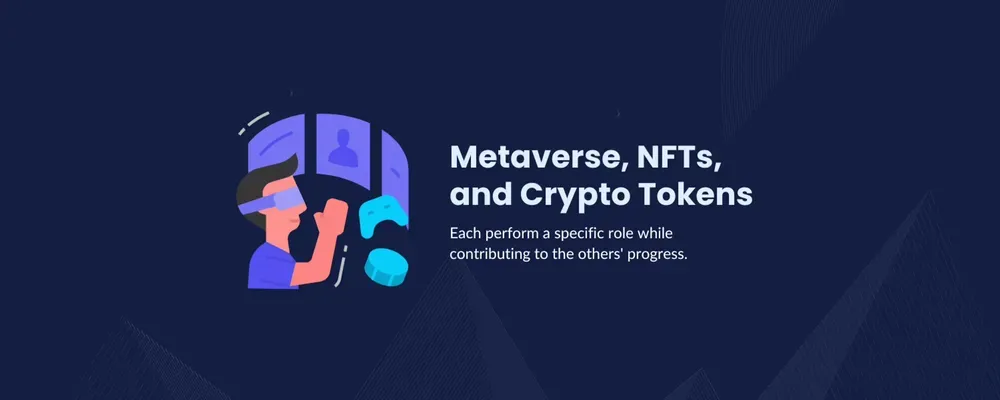Metaverse, NFTs, and Crypto tokens: Differences & Intersections

Each of these entities, Metaverse, NFTs, and Crypto tokens, serves a specific role while also sharing and contributing to the evolution of the others.
If you wish to participate in the Metaverse and NFT universe, you can acquire necessary crypto tokens via platforms such as Binance, Coinbase, Pollygon, BitOasis, and BitOasis (in the MENA region).
In order to better understand them, let's first deconstruct each of these terms.
Metaverse
The metaverse is an online, three-dimensional cosmos comprised of numerous virtual locations. It resembles a futuristic version of the Internet. Users will be able to cooperate, meet, play games, and socialize in these 3D places using the metaverse.
NFT
NFT NFTs are digital assets that may be purchased and resold using blockchain technology. However, because they are not fungible, they are a different form of asset, one whose worth and appeal are based on value and demand.
Crypto Tokens, or Assets
Unlike crypto currencies, tokens do not have their own blockchain. They work with blockchain-based cryptocurrencies. Several tokens, for instance, operate on Ethereum, which also supports stablecoins.
Now that we've defined each of the three stars, let's see how they combine.
Metaverse & NFTs
A Metaverse is a virtual representation of the physical world. In these virtual worlds, users can utilize a virtual self – a customizable avatar – to attend concerts, visit art galleries, and travel to distant countries.
There are also multiple Metaverses. And a number of companies are developing a range of network protocols, each with its own set, most famous -yet not launched- is Meta. The purpose of these Metaverses is to increase the overlap between our physical and digital lives.
Cryptocurrencies are digital assets that are utilized as a medium of exchange and a store of value in these virtual worlds. Additionally, there are NFTs, which enable the acquisition or sale of unique digital artworks on the blockchain.
When it comes to art, only a few of people can claim to own a Monet. Prints of the original are possible, but they are not nearly as valuable as the original because, unlike the impression, ownership is not transferred.
The equivalent idea applies to NFTs. The ownership of the NFT is confirmed on the blockchain via numerous network operations, thereby establishing without a doubt the genuine ownership of any work of art.
NFTs allow users to have complete ownership over their digital assets in the Metaverse. The blockchain technology provides irrefutable proof of ownership for these virtual universes.
For example, if you purchased a large quantity of LAND in Decentraland, the Metaverse would provide you with confirmation in the form of NFTs, which would be backed by the blockchain.
In the Metaverse, NFTs are also vital for creating unique experiences and boosting the digital community and social experiences.
Premium NFTs are utilized to get entry to the richest and most affluent communities in the digital world, as well as to obtain unique benefits, staking prizes, and other valuable items.
The Bored Ape Yacht Club and CryptoPunks collections, for instance, give access to premium communities with password-protected content and even offline parties to a small group of members.
Metaverse & Crypto
Cryptocurrencies are the currency of the Metaverse, and each Metaverse has its own coinage. They are used to pay for everything, including non-fungible tokens, virtual property, avatar footwear, and more.
For example, Decentraland's native token, MANA, can be used to purchase or sell anything on the platform. SAND, the native token of the Sandbox, is utilized in another famous Metaverse.
Cryptocurrencies connect the real and virtual worlds. They enable us to determine the worth of digital assets in fiat currency as well as their returns over time. The liquidity of cryptocurrencies on global exchanges also enables investors to generate money by selling coins and NFTs directly to purchasers.
How does Ethereum come into play?
After Bitcoin, Ethereum is the second-largest cryptocurrency by market capitalization. Not only is it a highly regarded coin, but it also serves as a development framework for the creation of Metaverses.
The vast majority of tokens, including MANA and SAND, are ERC20 tokens that lack their own blockchains.
They utilize the Ethereum network to validate transactions and extend their business. Even if the platforms themselves were developed on MANA or SAND, everything behind the scenes is Ethereum.
Ethereum is also the currency of choice on OpenSea, the largest NFT platform in the world. Additionally, the bulk of NFTs can be acquired directly from a crypto wallet using ETH.
Ethereum is the driving force behind these three principles and a multitude of other developing technologies, such as DeFi and dApps. Consequently, it is one of the few Blockchains that permits Metaverses, NFTs, and cryptocurrencies to interact.
So, to sum up
While the metaverse is still in their infancy, many firms are already experimenting with this virtual environment. The metaverse offers crypto a tremendous potential. It has the ability to alter how individuals socialize, observe performances, interact with companies, study, and trade digital assets. As crypto becomes the means of commerce in the metaverse, its utility and adoption are growing more widespread.
NFTs are investing in the Metaverse for luxury fashion labels such as Louis Vuitton, Gucci, Burberry, Adidas, and Nike. They foretell a future in which digital fashion will be equally dynamic as physical fashion. However, access to high-end apparel is not the only issue. Soon, Walmart intends to offer NFTs and its own cryptocurrency to investors, elevating convenience to the level of luxury.
I will be writing more articles, breaking down best examples of Metaverse & NFT usage, the different Metaverses comparison, and keeping you updated on the interesting developments of this world, so signup to my newsletter won't you?



Discussion